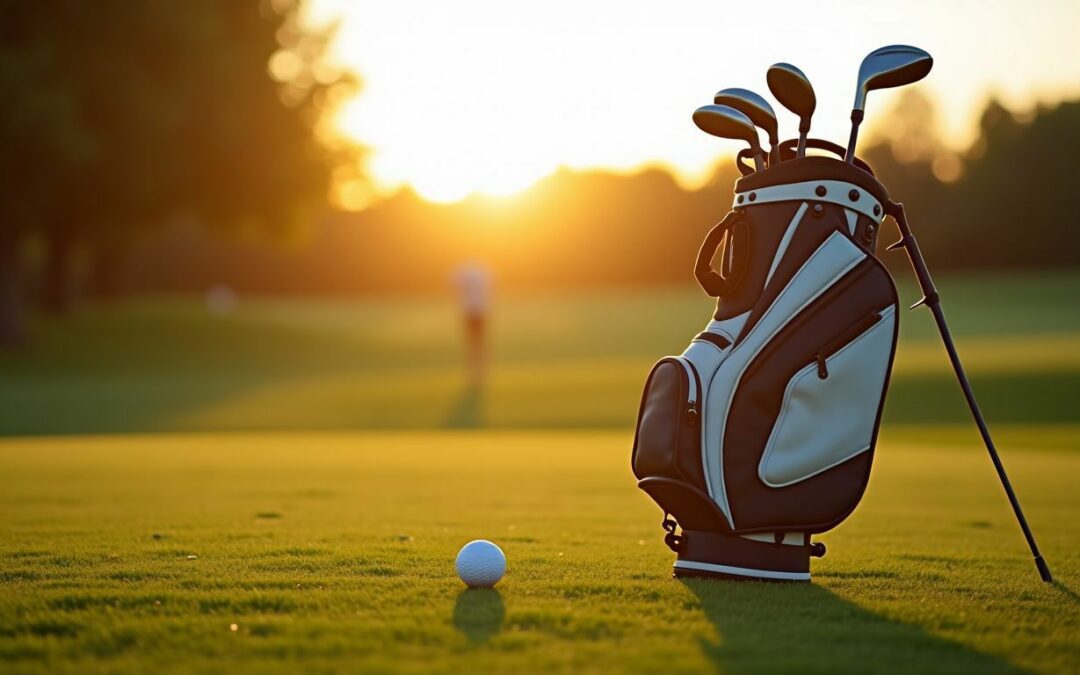Choosing the right golf gear can feel confusing, especially with so many options out there. A standard golf set includes clubs like drivers, irons, wedges, and a putter—each serving a unique purpose on the course.
This Golf Gear Guide will break down all you need to know about equipment for beginners and pros alike. Get ready to tee off with confidence!
Key Takeaways
- A standard golf set includes drivers, irons, wedges, a putter, and sometimes hybrids or fairway woods. Each club serves specific purposes for different shots.
- Drivers are best for long-distance shots; beginners should use forgiving lofts like 10.5° or 12°. Brands like TaylorMade and Callaway are popular choices.
- Two-piece golf balls suit beginners with strong durability and reduced spin. Multi-layered balls cater to advanced players seeking better control and precision.
- Essential gear includes gloves for grip, towels for cleaning clubs/balls, markers to spot ball positions, tees for setup, and lightweight bags with enough storage.
- Advanced tools like GPS watches or range finders help measure distances accurately while divot tools repair course damage caused by golf balls landing on greens.
Golf Clubs: The Core of Your Gear
Golf clubs are the backbone of golfing. Each type plays a key role in improving your game and handling different course challenges.
Driver
The driver is the powerhouse of any golf club set. It’s built for long shots, offering maximum distance off the tee. Beginners usually start with a forgiving 10.5° or 12° loft to help launch the ball higher and straighter.
Professional golfers like Bryson DeChambeau smash drives beyond 300 yards using advanced drivers designed for speed and control.
Brands like TaylorMade and Callaway dominate this space, making models that blend power with precision. Drivers often feature large clubheads (460cc max) for a bigger sweet spot, boosting your confidence at every swing.
Pairing it with quality golf balls can make all the difference on wide fairways and tricky par-4 holes.
“Good drives lead to great scores; always invest in a reliable driver.”
Irons
Irons are vital tools for golfers. They are versatile and used for shorter shots or precise hits toward the green. A standard beginner set typically includes eight irons, ranging from a 3-iron to a pitching wedge.
Lower-numbered irons, like the 3 or 4, hit longer distances but require skill. Higher numbers, such as the 8-iron or 9-iron, offer more control and loft.
Popular brands like Mizuno and Titleist produce high-quality options trusted by players worldwide, including PGA Tour pros. Blade irons provide skilled golfers with precision while cavity-backs help beginners get more consistency on each swing.
Different designs cater to varying levels of play. Wedges follow immediately after irons in use due to their short-range focus.
Wedges
Wedges are crucial for short-distance shots and tight situations. A pitching wedge is standard, but beginners might benefit from adding another option like a sand or lob wedge. These clubs help with high-arching shots over bunkers or getting out of tough spots on the golf course.
Popular brands such as Mizuno and Callaway offer quality wedges designed to improve accuracy. The “Vokey design” by Titleist is also favored among advanced players due to its precision milling process.
Having the right wedges in your bag can make chip shots and putts smoother, boosting confidence on tricky terrain near the green.
Putter
A putter handles the final touch on every hole. It’s crafted to roll the ball smoothly across the putting green toward the cup. Both beginners and pros know its importance, as even Phil Mickelson has relied on his trusty models during high-stakes moments.
Popular brands like TaylorMade and Titleist offer a range of options for players. A beginner’s 12-piece golf set often includes one, perfect for practice or casual play. Some designs feature alignment aids to steady aim, while others focus on weight balance for better control.
“Putting is an art,” many say in golf circles—it truly can make or break your game.
Hybrids and Fairway Woods
The hybrid club bridges the gap between irons and woods, offering control and power. Many beginners prefer hybrids because they’re easier to hit than long irons. A popular choice is a 4-hybrid which can replace harder-to-hit clubs like the 3 or 4 iron.
These clubs are great for tricky lies on rough grass.
Fairway woods, like the 3-wood or 5-wood, shine during long shots from fairways or even off tees when accuracy beats distance. The larger head of a fairway wood offers forgiveness on mishits while providing good lift.
Golfers often keep these as must-have tools in their golf bags for versatility across courses.
Golf Balls: Choosing the Right Fit

Picking the right golf ball can change your game. The type you choose depends on distance, control, and how much spin you want.
Two-piece golf balls
Two-piece golf balls are perfect for beginners and high-handicap golfers. They feature a solid rubber core with a durable outer cover, making them strong yet straightforward. This design boosts distance while lowering spin.
Golfers who want straight shots or extra yardage will appreciate these balls.
Their tough cover resists cuts and scuffs, lasting through many rounds. With less spin, they reduce slices or hooks, helping players keep shots on track. These balls also shine in affordability, proving great value for those just starting their journey in the game of golf!
Multi-layered golf balls
Multi-layered golf balls are built with three or more layers. Three-piece balls offer better control, making them ideal for intermediate players learning spin and precision. Four-piece designs cater to advanced golfers, offering high spin rates and a softer feel for added finesse on greens.
These balls suit those playing at higher levels or on challenging golf courses.
Each additional layer impacts how the ball behaves during play. The outer cover enhances durability, while inner cores adjust speed and distance. Players like Jason Day often favor premium multi-layered options for tournaments like the PGA Tour due to their impressive performance in demanding conditions.
Essential Accessories for Every Golfer

The right accessories can make or break your game. From staying organized to handling tricky shots, these tools set you up for success.
Golf Bag
A golf bag is more than storage; it’s an essential. Lightweight bags work best for walkers, helping them move easily across the course. A bag with ample pockets saves headaches. Store your golf balls, tees, gloves, and a towel without clutter.
Look for padded straps or easy-to-carry handles for comfort during long rounds. Some bags include stands to keep them upright on uneven ground. High-quality materials ensure durability in all weather conditions—rain or shine won’t ruin your day!
Tees
Tees lift the golf ball off the ground for cleaner hits. Longer tees work best for drivers and allow higher ball elevation. Shorter tees suit irons, hybrids, or fairway woods, providing consistent contact.
Wooden tees are common and eco-friendly but can break easily. Plastic options last longer yet may bend over time. Adjustable height gives flexibility for different clubs and swings—setting players up for better shots every time! Next comes another key item: the ball marker.
Ball Marker
A ball marker helps golfers spot the exact position of their golf ball on the green. It’s small, flat, and easy to carry. Golfers often use coins or poker chips as substitutes if they don’t have a dedicated one.
These markers prevent confusion during play and keep things fair for everyone. Using a sturdy, visible marker is key. Some even prefer custom designs for personal flair or practicality. Many pro shops sell them near counters with other golf accessories like divot tools or tees. A simple tool, but it keeps games smooth and organized!
Towel
A golf towel is a must-have for every golfer. It keeps clubs and balls clean, improving performance. Dirt or grass on equipment can affect shots, so wiping it off helps maintain accuracy.
Attach one to your golf bag for easy access during play.
Spills happen on the course—water bottles tip, or hands get sweaty. A good towel handles those situations too. Opt for microfiber ones; they absorb more and dry faster. It’s a simple item but makes a big difference in keeping gear ready round after round.
Golf Glove
A golf glove boosts the grip on the club, especially in humid or rainy weather. It reduces slipping and offers better control during swings. Most golfers wear it on their non-dominant hand—for example, right-handed players use a left-hand glove.
These gloves also lower friction between the hand and club, preventing blisters.
Options range from leather to synthetic materials, fitting all budgets. Leather gloves feel softer but might not last as long. Synthetic ones are more durable but less breathable. It’s wise to find one that fits snugly without feeling tight for maximum comfort and performance on the course.
Apparel for Comfort and Performance
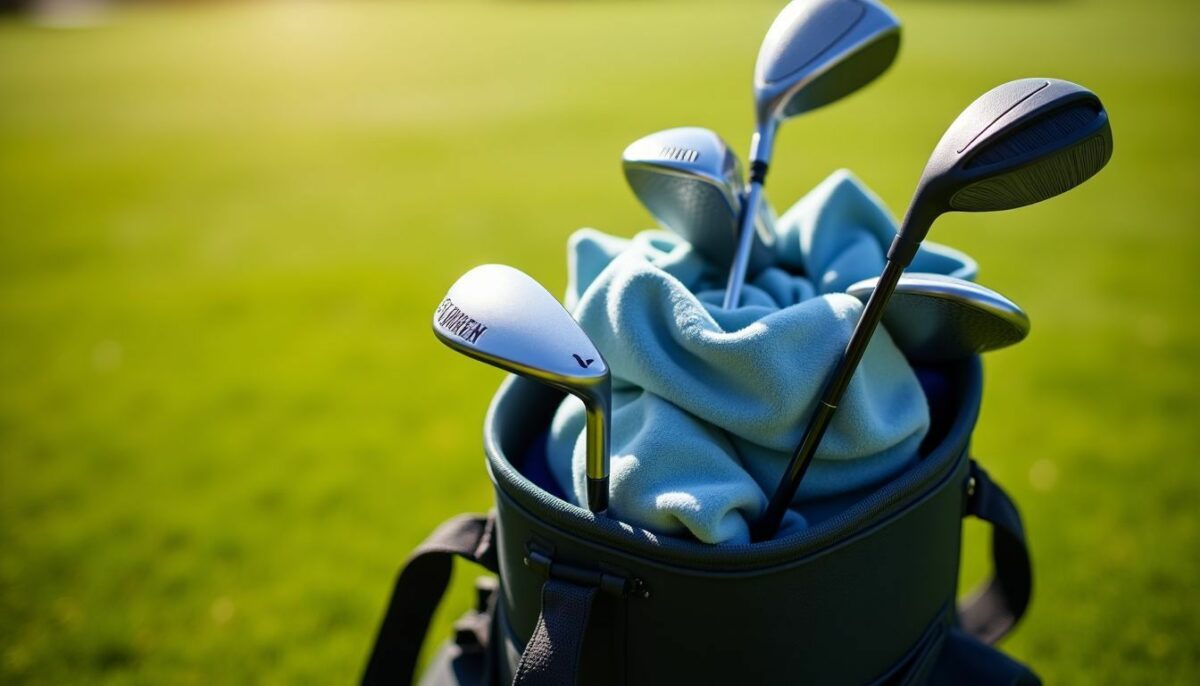
The right clothing keeps golfers comfy and focused. Good apparel can improve movement, grip, and even confidence on the course!
Golf Shirts
Golf shirts are essential for keeping comfort and meeting dress codes. Men should wear collared shirts, typically polo-style. Women can choose modest options like sleeveless tops with collars or short-sleeve blouses.
Avoid tank tops and t-shirts, as golf courses usually ban those.
These shirts often use lightweight, breathable materials like polyester blends. Moisture-wicking fabric helps players stay cool on hot days. Many golfers pick neutral or pastel colors to match other gear easily.
Up next: finding the perfect bottoms for every tee-off moment!
Golf Pants or Shorts
Cotton or polyester fabrics dominate golf pants and shorts. They allow flexibility and keep players comfortable on the course. Many clubs frown upon jeans, so stick with these approved materials for a polished look.
Choose pants or shorts based on weather. Shorts keep you cool during warmer months, while long pants protect in cooler conditions. Neutral colors like khaki, gray, or navy pair well with most golf shirts and meet dress codes at courses worldwide.
Golf Shoes
Golf shoes grip the ground, keeping your stance steady. Spiked designs are highly recommended and work well on damp or uneven courses. They help players avoid slipping during swings.
Soft spikes provide extra comfort while maintaining a firm hold.
Trainers, boots, or sandals are not allowed on most golf courses—they lack traction and professionalism. Modern golf shoes combine style with function. Lightweight materials make them comfortable for long rounds without causing drag.
For added support, look for options with padded soles and waterproof builds.
Advanced Gear for Better Play
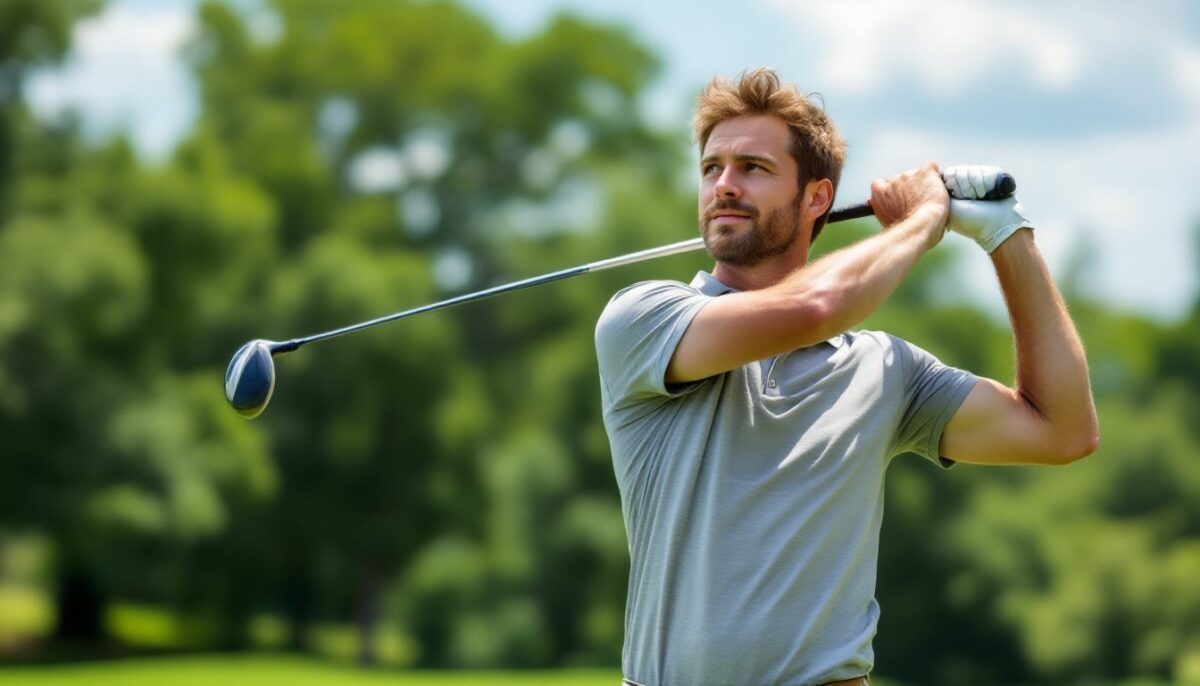
Advanced gear can take your game to the next level. Tools like tech gadgets and specialty items offer precision, saving you strokes on the course.
Range Finder or GPS Watch
A range finder or GPS watch helps golfers measure distances with ease. These tools provide accurate yardages to the hole, hazards, and other key spots on the course. A range finder uses lasers to pinpoint exact measurements, while a GPS watch gives real-time data based on satellite positioning.
For tech-savvy players, a GPS watch can track rounds and analyze performance stats. Range finders are often preferred for their precision when targeting pins or tricky angles. Both improve decision-making during play and save time over manual calculations.
Divot Tool
A divot tool fixes damage on the green caused by golf balls. It keeps the course smooth and prevents uneven surfaces. Golfers use it to push turf back into place after leaving marks, helping maintain fair play for everyone.
This small accessory is a must-have in every golf bag. Using one shows respect for courses and fellow players. Most tools are lightweight, made of metal or plastic, and fit easily in your pocket or glove compartment.
Some even double as a ball marker!
Wire Brush
A wire brush is a small yet powerful golf accessory. It cleans dirt, grass, and debris off club faces with ease. This keeps grooves sharp, which helps maintain spin and control on every shot.
A clean club performs better on the course.
Many brushes clip onto a golf bag for quick access. They usually feature stiff bristles and a sturdy handle for durability. Some models come with retractable cords or ergonomic grips for added convenience.
Keeping clubs clean improves both performance and longevity—simple but critical care!
Seasonal and Weather-Specific Gear

Staying prepared for rain or shine keeps your game steady, no matter the forecast.
Rain Gear
Golfers should pack waterproof clothing. Jackets and pants made with lightweight, breathable materials keep players dry without restricting movement. A golf bag with water-resistant fabric protects gear during unexpected downpours.
Carrying a sturdy golf umbrella is smart, especially in places like the UK. The weather there can change fast, leaving golfers soaked without one. Pairing this with a high-quality golf towel ensures clubs and grips stay clean and usable even in wet conditions.
Sun Protection Essentials
A wide-brim golf hat shields the face, neck, and ears from harsh sunlight. Caps help but leave parts of the skin exposed. Sunscreen is a must—apply it generously before starting and reapply every two hours for lasting safety.
Use SPF 30 or higher for full protection during long rounds on sunny days.
Lightweight clothing with UPF fabric adds another layer of defense against UV rays. Carry sunglasses to protect your eyes and reduce glare when lining up shots. Playing in intense heat? Pack extra water bottles to stay hydrated while staying sun-safe.
Beginner-Friendly Gear Recommendations
Starting golf doesn’t mean breaking the bank—choose starter gear that’s simple, reliable, and made for learning.
Starter Club Sets
Starter club sets simplify golf for beginners. A typical 12-piece set includes three woods, eight irons, and one putter—everything needed to hit the course. Many sets also have a hybrid or extra wedge for added versatility.
These clubs help ease players into mastering swings without breaking the bank.
Most starter kits include lightweight designs for better handling and control. Affordable options make them perfect for learning basic skills while sticking to a budget. It’s an easy way to step onto the fairway with confidence!
Affordable Golf Balls
Affordable golf balls help save money without sacrificing play. Beginners and high-handicap golfers often lose or damage many balls due to inconsistent swings, so buying large packs of durable, medium-compression ball options can be smart.
Two-piece golf balls are a good choice for these players since they’re budget-friendly and designed for distance.
Brands like Pinnacle and Wilson offer reliable options under $20 per dozen. These balls provide decent performance while being cost-effective. Investing in affordable choices helps new players focus on improvement without worrying about the price of every lost ball.
Tips for Maintaining Your Golf Gear
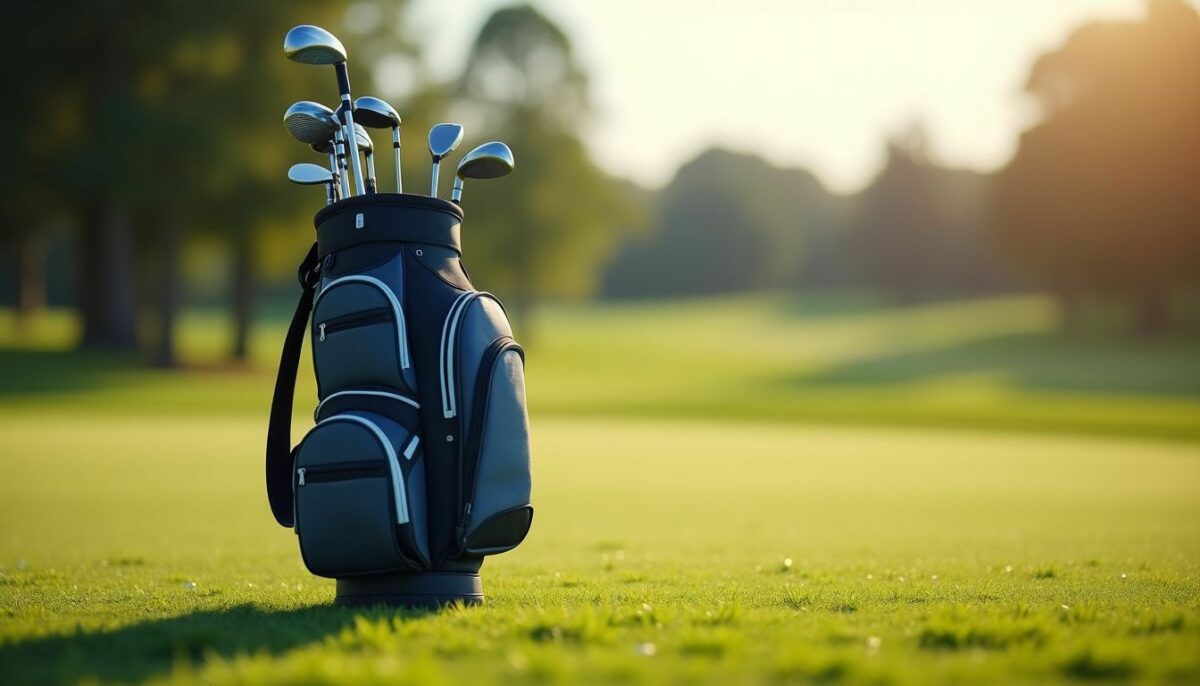
Keep your golf gear clean and organized, so it’s ready to perform every time you hit the course.
Cleaning Clubs and Balls
A dirty club can ruin a swing. Dirt in the grooves of your clubs affects spin and control. Use a golf towel to wipe down the face after every shot. For deeper cleanings, grab a wire brush to clear out stubborn grime.
Soapy water works wonders for removing dried mud.
Golf balls need attention, too. Mud or grass stains on them can alter flight paths. Rinse balls with water during your round using ball washers found at most courses. At home, use warm soapy water for dirt build-up that won’t come off easily.
Proper Bag Organization
Sort golf clubs in the bag by type. Place drivers and fairway woods in the back compartment. Use the two center compartments for irons and hybrids, keeping them snug to avoid scratches.
Store wedges and your putter in the front compartment—quick access saves time on the green.
Group small golf accessories like tees, a ball marker, or divot tool together. Use side pockets for a golf towel and extra golf balls. A water bottle fits well in an outer pocket for easy reach during hot games.
Keep rain gear or a golf umbrella tucked neatly in sections designed for larger items.
Conclusion
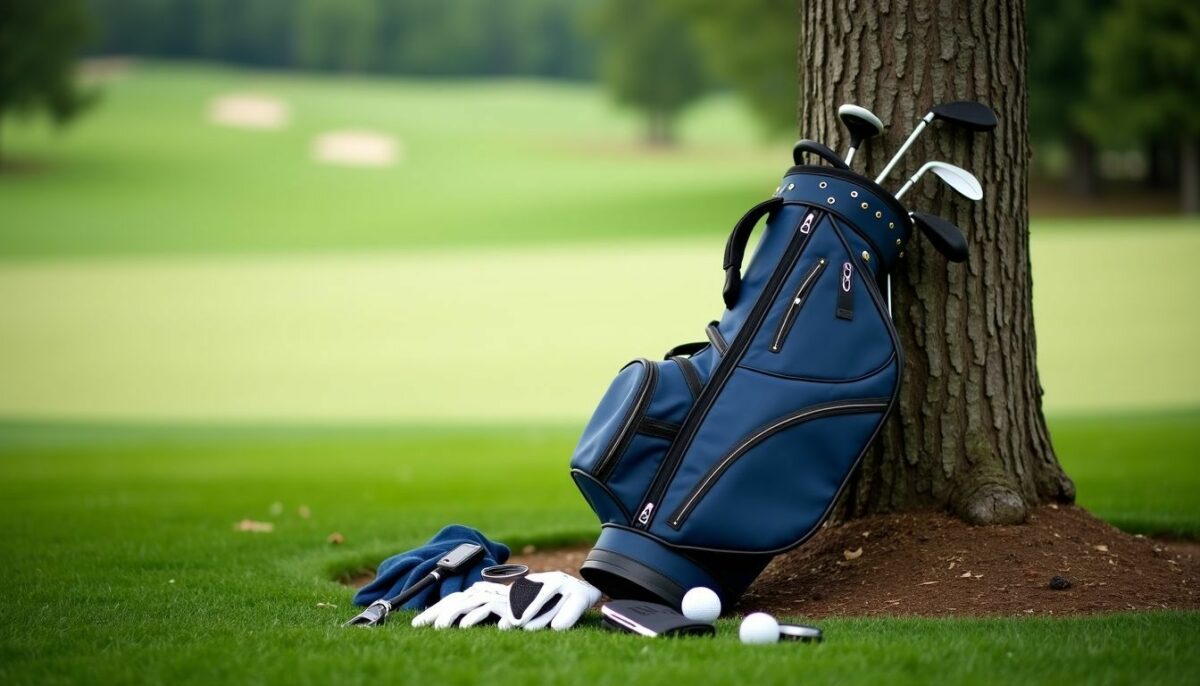
Golf gear can feel overwhelming, but it doesn’t have to be. The right equipment can boost your game and make every round more enjoyable. Start with the must-haves, like clubs and balls, then add extras like gloves or a GPS watch as you grow in skill.
Whether you’re new to golf or a seasoned player, having the right tools makes all the difference on the course. Grab your bag, hit the green, and enjoy!
FAQs
1. What golf equipment do beginners need to get started?
Beginners should start with the basics: a set of golf clubs, a golf bag, and some golf balls. Add essentials like a divot tool, ball marker, and a wire brush for upkeep. Comfortable running shoes can work until you invest in proper golf shoes.
2. Why is a golf glove important?
A good golf glove improves grip on your club and prevents blisters during play. It’s one of those small accessories that makes a big difference—especially on hot days or long rounds.
3. Do I really need all the extra gear like umbrellas or towels?
Not everything is essential, but items like a water bottle, towel, or even a sturdy golf umbrella can save your day when weather strikes or sweat builds up mid-round.
4. How does technology improve my game?
Golf technology includes tools like GPS apps on your smartphone to measure distances accurately or advanced club designs tailored for performance through professional fitting sessions.
5. What’s the deal with “golf etiquette” everyone talks about?
Golf etiquette means showing respect for others on the course—like repairing divots with your tool, keeping quiet during swings, and dressing modestly (no jeans!). It’s as much about manners as it is skill!

